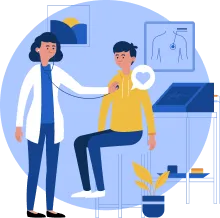BEYOND THE ORDINARY
Boost Your Business Performance with
Supervised Learning Solutions
"BlueBash AI leverages supervised machine learning to drive substantial business transformation, empowering organizations to achieve goals, enhance productivity, automate tasks, and gain data-driven insights, fostering innovation and efficiency in today's competitive landscape."
Let’s Build Your Business Application!
We are a team of top custom software developers, having knowledge-rich experience in developing E-commerce Software and Healthcare software. With years of existence and skills, we have provided IT services to our clients that completely satisfy their requirements.
What We Offer in Supervised Machine Learning
Predictive Analytics
Predictive analytics harnesses historical data to anticipate future outcomes using techniques such as regression, neural networks, Random Forest, and Gradient Boosting. After training on known input-output pairs, the model can make predictions with new data. This has versatile business applications, including :
Forecast Demand
Optimise Pricing
Anticipate Customer Behaviour
Classification Algorithms
It entails sorting data into predefined categories using algorithms like Decision Trees, Support Vector Machines, and Logistic Regression. Through training on labeled data, such as classifying emails as 'spam' or 'not spam,' the model learns to categorise new data accurately based on their attributes.This has versatile business applications, including :
Business Applications
Customer Segmentations
Targeted Marketing
Fraud Detection
Custom Supervised Models
We specialize in tackling industry-specific, unique challenges, such as refining specialized manufacturing processes or predicting the success of a new product launch. Our approach involves customizing models to your specific data, ensuring a higher return on investment by optimizing solutions for your individual business hurdles.
Solve niche problems
Tailoring models to your data
History of Supervised Machine Learning

Early Foundations
-
1950:
Turing proposes the Turing Test, setting the groundwork for AI.
-
1957:
Rosenblatt introduces the Perceptron, an early supervised learning model.
Neural Networks
-
1960:
Widrow and Hoff develop ADALINE, a precursor to neural networks.
-
1965:
Early concept of Support Vector Machines (SVMs) is introduced.
Algorithmic Enhancements
-
1970:
The "No Free Lunch Theorem" highlights the need for specialised algorithms.
-
1974:
Back propagation algorithm improves multi-layer neural network.
Mainstream Adoption
-
1986:
Back propagation popularised for training neural networks.
-
1989:
LeNet shows the utility of Convolutional Neural Networks (CNNs) in digit recognition.
Ensemble Methods
-
1991:
Introduction of Random Forests enhances Decision Trees.
-
1997:
Support Vector Machines (SVMs) gain mainstream attention.
Big Data and Scalability
-
2006:
Geoffrey Hinton introduces the concept of "Deep Learning."
-
2010:
Random Forests and Gradient Boosting Machines optimized for big data.
Specialisation and Achievements
-
2012:
AlexNet wins the ImageNet competition, popularizing deep learning.
-
2016:
Google's AlphaGo, partially trained via supervised learning, beats a Go world champion.
Real-World Applications and Ethics
-
2020-2021:
Use of supervised learning in COVID-19 solutions.
-
2021:
Discussions around ethics, fairness, and transparency in supervised learning.
Why Bluebash AI for Supervised Learning?
-
Focused Expertise:
Specialized in data pipelines, offering the most advanced solutions.
-
Quick Deployment:
Rapid integration into your existing systems for immediate benefits.
-
Secure and Scalable:
Designed with data security and scalability in mind.
-
Customer-Centric:
Tailored solutions to meet your unique challenges.

Case Study: Supervised Learning

Retail: Dynamic Pricing Model
BlueBash AI implemented a supervised learning model that dynamically adjusts pricing based on multiple factors like demand, time of day, and inventory.

Healthcare: Early Disease Detection
We designed a supervised learning model that analyses patient data for early signs of the disease.
Finance: Fraud Detection
BlueBash AI deployed a real-time supervised learning model that flags suspicious transactions.
Frequently Asked Questions
Machine learning refers to a system's capability to learn tasks without explicit programming, relying on provided data. It involves creating computer programs that can access data and independently learn from it.
Supervised learning involves training a model using labeled data. It learns from known input-output pairs to make predictions or decisions when new data is encountered.
Our solutions are crafted by expert developers, leveraging cutting-edge algorithms to deliver tailored, high-performance machine learning applications that cater to your specific needs.
From consultation to deployment, our experts guide you through the entire process, offering comprehensive development services for creating robust machine learning solutions.
Our solutions cater for various sectors, including finance, healthcare, retail, and more, optimizing operations and decision-making processes through advanced AI technology.
Yes, we specialize in developing machine learning applications, ensuring seamless integration of AI into your software for enhanced functionality and performance.


